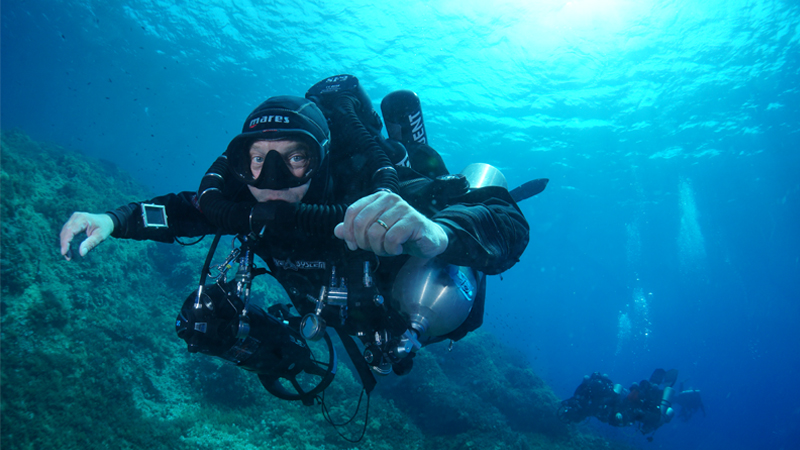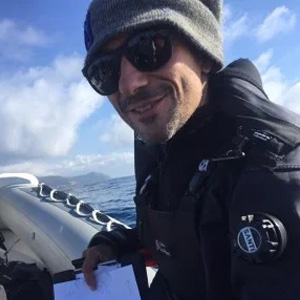Breathing underwater isn’t just a necessity—it’s an art. How you manage your breathing directly impacts your safety, air consumption, and the quality of your dive. In this guide, we’ll explore top techniques to improve your underwater breathing, reduce stress, and extend your bottom time.
Indice:

Underwater breathing techniques: how to optimize air consumption
One of the most common mistakes among divers, especially beginners, is breathing too fast and shallow. The key to better efficiency lies in diaphragmatic breathing, a method that helps you use your full lung capacity and consume less air.
How to breathe efficiently underwater
- Slow, deep inhalation: When you inhale, let your abdomen expand naturally, filling your lungs completely.
- Controlled, full exhalation: Release air slowly and steadily, avoiding sharp exhales that could disrupt your buoyancy.
- Consistent rhythm: A full inhale-exhale cycle should last around 12–15 seconds, helping you lower your breathing rate per minute.
Pro Tip
Practice this technique with dry breathing exercises before diving. Training at home makes it easier to apply underwater.
How to reduce air consumption while diving
If you find yourself running out of air quickly, the solution isn’t just about breathing—it also involves technical adjustments:
- Optimize your buoyancy: Good buoyancy control reduces unnecessary movement and air usage.
- Reduce excess weight: Too much weight makes you work harder with your fins, increasing effort and gas consumption.
- Balance your trim: Proper weight distribution helps you maintain position without straining your back or glutes.
- Improve hydrodynamics: Stay horizontal and reduce water resistance.
- Avoid unnecessary movement: Be mindful with your motions—use only what’s essential.
- Stay mentally relaxed: Anxiety and stress increase air usage. Focus on your breathing and enjoy the dive.
Want to improve your air consumption effectively?
Join our advanced courses and learn the secrets of underwater breathing with our expert instructors.
What gases do divers breathe? Air, Nitrox, and Trimix explained
Depending on the type of dive, divers may breathe different gas blends.
Compressed air
Underwater, divers breathe the same composition as surface air:
- 21% Oxygen
- 78% Nitrogen
- 1% Other gases
However, nitrogen can cause side effects like nitrogen narcosis, which is why alternative blends are used for deeper or longer dives.
Nitrox: benefits and limits
Nitrox contains a higher oxygen percentage than air—usually between 32% and 40%. Its main benefits:
- Longer bottom times due to reduced nitrogen saturation
- Less fatigue after diving
- Lower risk of decompression sickness
⚠️ Warning ⚠️
Nitrox has depth limits due to oxygen toxicity. You’ll need a special certification to use it safely.
Trimix: the blend for technical diving
For deep diving, Trimix is used. This mix includes:
- Oxygen
- Nitrogen
- Helium (which lowers the gas density and reduces narcosis risk)
Trimix is essential for dives beyond 50 meters, where both nitrogen and oxygen can become problematic.
Looking to go deeper?
Explore our Nitrox and Trimix courses for advanced technical diving.
How long does a scuba tank last?
Tank duration depends on several factors:
- Tank size (7, 10, 12, 15, 18 liters or twin tanks)
- Dive depth (the deeper you go, the more you consume)
- Individual breathing rate
Example: A 12-liter tank at 200 bar holds about 2400 liters of air. If a diver breathes 20 liters per minute at 20 meters (3 bar), their autonomy is around 40 minutes.

Want to extend your dive time?
Our instructors can help you improve your technique and buoyancy control.
How does a scuba regulator work?
The regulator lets you breathe underwater by reducing the air pressure from your tank. It operates in two stages:
- First stage: Lowers the pressure from the tank to an intermediate level
- Second stage: Adjusts airflow to match ambient pressure so you can breathe comfortably
A high-quality regulator and regular maintenance are crucial for underwater safety.
Need help with your regulator?
We offer servicing and inspection at our diving center.
Underwater breathing is the core of every dive. Mastering it enhances your experience, reduces air consumption, and boosts safety.
Whether you’re a beginner or a seasoned diver, there’s always room to grow.
Ready to take your dives to the next level?
Explore our advanced breathing, air management, and gas mixture courses.
We’ll see you underwater! 🌊



